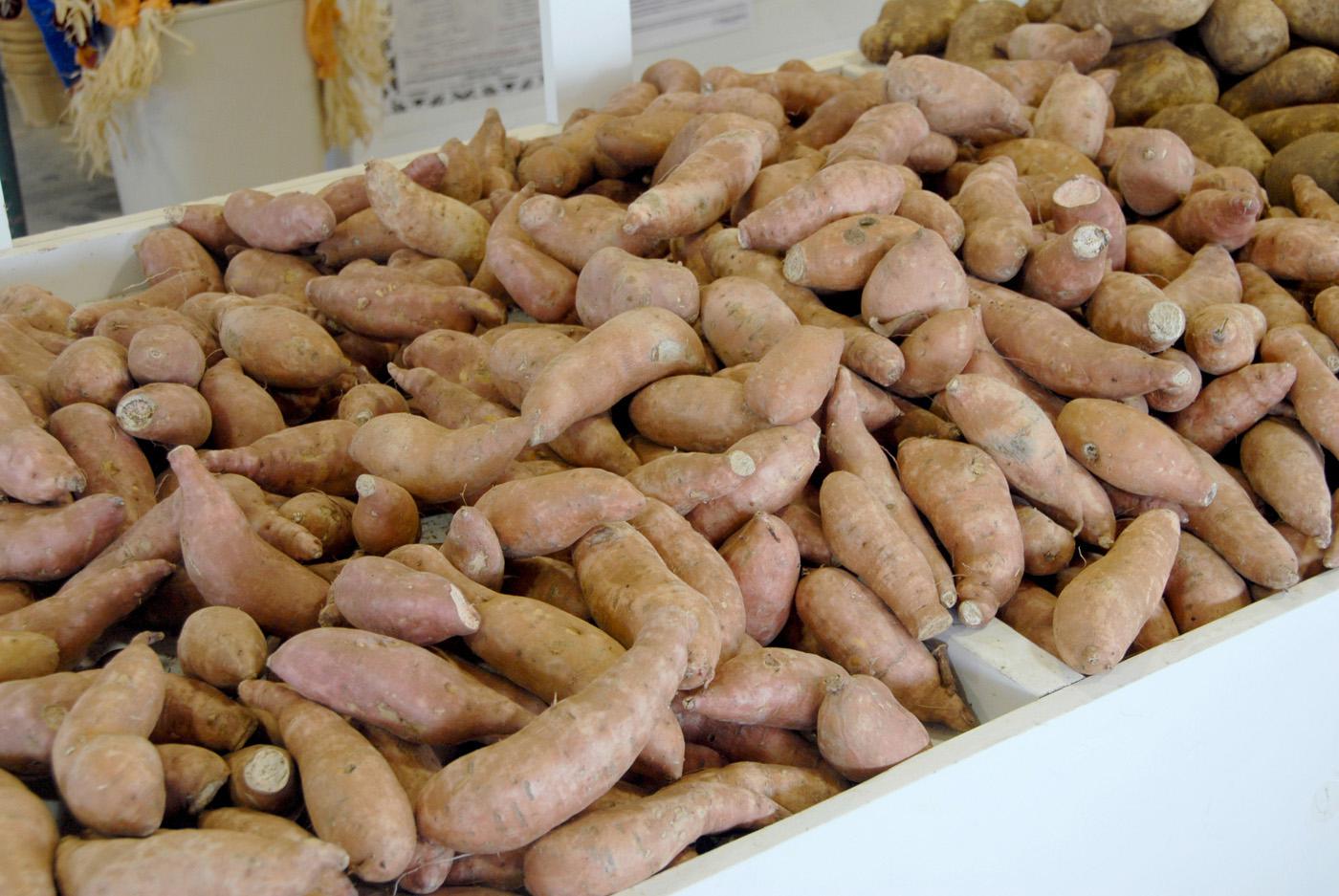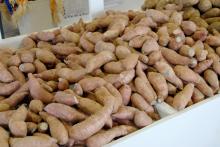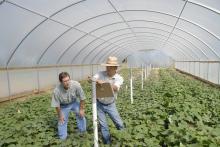Information Possibly Outdated
The information presented on this page was originally released on October 22, 2009. It may not be outdated, but please search our site for more current information. If you plan to quote or reference this information in a publication, please check with the Extension specialist or author before proceeding.
New research to aid sweet potato growers
By Karen Templeton
MSU Ag Communications
MISSISSIPPI STATE – As Mississippi’s sweet potato industry continues to grow, researchers at Mississippi State University are developing even more innovative and effective strategies for growers.
Sweet potatoes have been grown in the southeastern United States since 1648 and are an important crop for Mississippi. The state’s soil and climate produce quality sweet potatoes. The industry has grown steadily, and today there are more than 90 sweet potato operations within 40 miles of Vardaman, in the northeast part of the state.
“Mississippi is second in the nation in planted sweet potato acreage,” said Benny Graves, executive secretary of the Mississippi Sweet Potato Council. “It is the No. 1 vegetable crop in the state.”
Sweet potatoes have become a popular food around the country and overseas. Mississippi sweet potatoes are sold everywhere east of the Rocky Mountains and exported to Canada and the United Kingdom.
“People have come to realize the value in eating such a nutritious food. Baby boomers are switching to healthier foods, and sweet potatoes fit perfectly into their diets,” Graves said. “The vegetable is also being used in baby food and frozen casseroles. Sweet potato fries are a rising food trend and are on many restaurant menus.”
A large national and international demand for sweet potatoes has made Mississippi’s crop even more important. That is why researchers at MSU are focusing their efforts on developing systems and strategies to increase sweet potato production and profitability.
Pontotoc Ridge-Flatwoods Branch Experiment Station associate research professor Mark Shankle said MSU has secured a number of important sweet potato research grants.
“We are growing about 20,000 acres of sweet potatoes in the state,” Shankle said. “With the nationwide demand for the crop, we could expect to see our acreage increase. That expectation makes this an opportune time to focus on research that will benefit the industry.”
One such project is the model-based decision support system. The multi-state grant for $2.8 million was awarded by the U.S. Department of Agriculture to researchers at MSU, Louisiana State University and North Carolina State University, and Extension specialists in California. LSU is the lead institution on the study.
“The study is basically about how different practices and environmental conditions influence the yield and quality of the crop,” said Ramon Arancibia, professor at the experiment station in Pontotoc. “We are going to analyze how certain factors and conditions contribute to or affect storage root initiation and growth of sweet potatoes. If storage root is not initiated and enlarged, then the root will remain as a feeding root with no commercial value.”
The researchers are developing a computer model that will allow sweet potato growers to input their current growing conditions, such as weather, soil moisture, number of nematodes, and timing of fungicide and herbicide applications, to get a probability of how their crop will turn out. The information provided by the computer model will enable growers to make the best management decisions for their crops.
“The modeling system is based on an approach called Bayesian networks. It is able to quantify risk and assists users in making decisions,” said Arthur Villordon, associate professor at LSU’s Sweet Potato Research Station. “It is really a very interesting approach. NASA has used it as a decision support tool for the space shuttle’s propulsion system.”
Arancibia and Villordon said the project will last at least three years, and growers in the participating states will be involved.
“Some of the growers have already seen the prototype and are realizing its potential,” Villordon said. “We want to make this system as user-friendly as possible, so their input is very important.”
Sweet potato growers also need new research on post-harvest practices to help them reduce the incidence of disease and increase the quality of their crop. Arancibia and his colleagues are embarking on a new study with USDA grant money through the Mississippi Department of Agriculture to help growers find solutions to post-harvest problems.
“The after-harvest curing process is important because it can heal injuries the sweet potatoes get during harvesting, but there are certain conditions needed to make this a more effective process,” Arancibia said. “The sweet potato is a tropical vegetable and needs warm conditions to thrive. Some of the harvest and post-harvest temperatures in Mississippi can be on the cold side, so we are looking at increasing temperatures in storage facilities to accelerate the healing process and reduce disease incidence.”
Arancibia said higher temperatures may also increase metabolic processes, giving the sweet potato an even sweeter taste.
“If the metabolic process is halted by cold temperatures, the potato does not reach its true taste potential,” Arancibia said. “Better curing practices benefit growers, as the sweet potatoes can be marketed for possessing certain culinary characteristics such as having a sweeter taste.”
The post-harvest storage project has just gotten under way, and many Mississippi growers are already participating in it.
The key to successful sweet potato research is grower participation. MSU Extension specialists are the liaisons to the growers and help recruit and conduct research projects. Extension agent Bill Burdine and Extension plant pathologist Alan Henn were the first in the state to initiate and engage growers in sweet potato end rot disease research.
“Because of the damage end rot can cause, we began looking at using biological materials that can be applied to protect the crop during storage,” Burdine said. “We’ve had good grower participation. They benefit from the research, as it helps put dollars back into the industry.”
Burdine and Henn have also been conducting studies on controlling nematodes, which can be destructive to sweet potato crops. Burdine said their work with growers has led to determining thresholds and finding more profitable solutions for controlling the destructive pest.
“Our priority has been having biweekly meetings with growers to update them on research and other pertinent information,” Burdine said. “This type of communication is important for us and them. We get immediate feedback on projects and get to share information on a regular basis.”
Burdine said the meetings are even more important this season, as much of the crop has been affected by the heavy rains.
Shankle said more research is on the horizon, and innovative projects are already under way.
“Mississippi State researchers are looking at the possibility of using sweet potatoes in ethanol production,” Shankle said. “Some grades of potatoes are not used and may be left in the fields or discarded. Ethanol production could be a way to make use of those excess potatoes and open new markets for producers.”
The new knowledge being brought to growers is needed to aid in the continuing success of Mississippi’s sweet potato industry.
“Growers have a financial stake in all of this,” Graves said. “The Sweet Potato Council has a long history with Mississippi State’s researchers and Extension agents. The research they develop and put in the hands of our growers is vital to the industry.”









